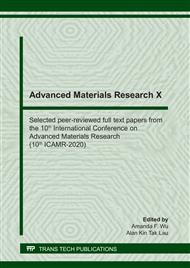[1]
Cichosz, P. and P. Karolczak, Sinker electrical discharge machining of aluminium matrix composites. Materials Science-Poland, 2008. 26(3): pp.547-554.
Google Scholar
[2]
Sivakumar, K. and R. Gandhinathan, Establishing optimum process parameters for machining titanium alloys (Ti6Al4V) in spark electric discharge machining. International Journal of Engineering and Advanced Technology (IJEAT), 2013. 2: pp.201-204.
Google Scholar
[3]
Gaikwad, V. and V.S. Jatti, Optimization of material removal rate during electrical discharge machining of cryo-treated NiTi alloys using Taguchi's method. Journal of King Saud University-Engineering Sciences, 2018. 30(3): pp.266-272.
DOI: 10.1016/j.jksues.2016.04.003
Google Scholar
[4]
Muthuraman, V. and R. Ramakrishnan, Multi parametric optimization of WC-Co composites using desirability approach. Procedia engineering, 2012. 38: pp.3381-3390.
DOI: 10.1016/j.proeng.2012.06.391
Google Scholar
[5]
Luis, C., I. Puertas, and Villa, Material removal rate and electrode wear study on the EDM of silicon carbide. Journal of materials processing technology, 2005. 164: pp.889-896.
DOI: 10.1016/j.jmatprotec.2005.02.045
Google Scholar
[6]
Zhao, J., et al., Analysis of the wear characteristics of an EDM electrode made by selective laser sintering. Journal of Materials Processing Technology, 2003. 138(1-3): pp.475-478.
DOI: 10.1016/s0924-0136(03)00122-5
Google Scholar
[7]
Marafona, J., Black layer characterisation and electrode wear ratio in electrical discharge machining (EDM). Journal of Materials Processing Technology, 2007. 184(1-3): pp.27-31.
DOI: 10.1016/j.jmatprotec.2006.10.045
Google Scholar
[8]
Kunieda, M. and T. Kobayashi, Clarifying mechanism of determining tool electrode wear ratio in EDM using spectroscopic measurement of vapor density. Journal of Materials Processing Technology, 2004. 149(1-3): pp.284-288.
DOI: 10.1016/j.jmatprotec.2004.02.022
Google Scholar
[9]
Priyadarshini, M. and K. Pal, Grey-Taguchi based optimization of EDM process for titanium alloy. Materials Today: Proceedings, 2015. 2(4-5): pp.2472-2481.
DOI: 10.1016/j.matpr.2015.07.188
Google Scholar
[10]
Huo, J., et al., Influence of process factors on surface measures on electrical discharge machined stainless steel using TOPSIS. Materials Research Express, 2019. 6(8): p.086507.
DOI: 10.1088/2053-1591/ab1ae0
Google Scholar
[11]
Le Xuan Hung, T.T.H. and V.N. Pi, A Study on Modelling Surface Finish in Electrical Discharge Machining Tablet Shape Punches Using Response Surface Methodology.
DOI: 10.17265/2162-5263/2017.07.006
Google Scholar
[12]
Hoang, T.T., et al., Modelling Surface Finish in Electrical Discharge Machining Tablet Shape Punches using Response Surface Methodology.
DOI: 10.17265/2162-5263/2017.07.006
Google Scholar


